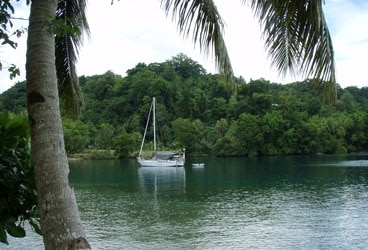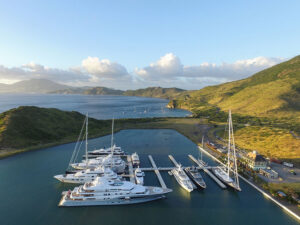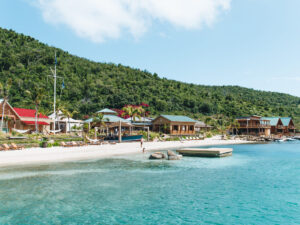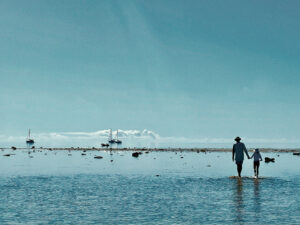
solomons 368
I first sailed to the Solomon Islands in 1980 on a loose affiliation of plywood planks named Zenie P II. In the capital, Honiara, on the main island of Guadalcanal, I was told that the neighboring island of Malaita was forbidden to tourists because the people were absolutely too wild and dangerous. I set sail for there immediately.
The Malaitans were indeed bone-in-the-nose wild and perhaps even dangerous, but they sensed my sincere interest in their way of life and generously took me into their huts and hearts. Emboldened with my success there, I spent the following eight months exploring countless islands, mountains, jungles, rivers, and villages in all but the easternmost province of Temotu, having been blown past there by Cyclone Fredrick.
I found the Solomon Islands to be a nation of abundant resources, breathtaking beauty, and wonderful people, but they are a people divided, even down to the village level. I awoke one morning to a note from a resident of a settlement within sight across the bay: “Simon, your life plenty danger in that village. They murders and thieves. You safe here. Come fast.”
To create a peaceful and prosperous future, an emerging nation and its people must somehow shed the divisive rivalries of the past and form a sense of mutual destiny. This hasn’t occurred in the Solomons.
Bright, aggressive, and populous, the Malaitans have for decades flocked to Honiara, taking up positions of influence there in government and business. This free flow of citizens within national borders may seem normal to residents of the industrialized democracies, but to the Gwale people of Guadalcanal, it was viewed as just another Malaitan invasion. Local resentment eventually led to violent conflict bordering on all-out civil war.
Hostilities have since ceased, the guns have been collected, and order has been restored, but the nation now lies close to economic and political ruin. The Regional Assistance Mission to the Solomon Islands-known as the RAMSI Force and made up of soldiers from Australia, New Zealand, and Fiji-is presently trying to fill the civic gaps, but the organization’s team is stretched thin, and its mandate is temporary.
However, while conventional tourism in the Solomon Islands has suffered, intrepid cruisers haven’t been deterred. Once the “Light Fee” has been paid-for the use of local navigational lights that, in fact, have yet to be installed-and a cruising permit issued, few restrictions are imposed these days. By keeping their ears tuned to the coconut telegraph and by avoiding known trouble spots, cruisers can wander almost at will through island-dappled lagoons, dive on pristine reefs and historic sunken wrecks, and probe unspoiled jungles. The carvings of Maravo Lagoon still rival the best in the world. I’d always had feelings of regret for missing the Santa Cruz and the Reef, or Swallow, islands, in Temotu Province, for these gems are sufficiently remote that most travel guides fail even to mention their existence.
These islands have another draw for me. Like larger, better-known Papua New Guinea and Fiji, the Solomons are part of a large subregion known as Melanesia, which lies northeast of Australia. Melanesians are recognized as the most successful farmers in history. Over the course of 30,000 years, they’ve developed a complex and sustainable system of agriculture. Unlike the Polynesians, however, they aren’t known for their maritime prowess-except for the residents of the Swallows.
As I planned my return to the Solomons, I consulted my old but trusted pilot book, which reported, “The inhabitants appear to be bold navigators, sailing their double canoes as far as Tikopia, which lies 190 miles southeastward. They were formerly reputed to be rough, treacherous, and fearless.”
Clearly, these were my kind of sailors, and I just had to meet them. But as I watched Diana grow ever more content in her garden, my hopes of ever seeing Temotu Province were ebbing. In 2002, after 20 years afloat, Diana and I had sailed to her native New Zealand for a much-needed break ashore. But after three years, this land life began to smack to me of permanency, and I was ready to move aboard and start exploring once again. Fortunately Diana’s other passion is textile art, especially native weaving. While visiting the Pacific Peoples section of the Auckland Museum, I saw her marveling over a banana-fiber weaving that incorporated an intricate and unique pattern. Flushed with excitement, she turned to me and said, “Take me to the Santa Cruz Islands.” I’ll admit that I’ve finessed that request into a four-year, 13-nation, 20,000-mile tour of the Pacific, but I believe that when opportunity knocks, you should throw the door wide open.
Gateway to the Solomons For us, sailing first through southern Melanesia created a context within which to approach the Solomon Islands. In Nouvelle-Caledonie, revenues from vast nickel deposits underpin the native Kanaks’ growing autonomy and their resurgence of cultural pride. The people of Vanuatu have little such material wealth, but they have cooperation among their many island tribes, a reputation for lawful and friendly conduct, and a land and location that beckon tourists from Australia and beyond.
Perhaps the demand for biofuels will reinvigorate the collapsed coconut plantations, but until the tourists return, the Solomon Islanders must rely on a waning fishing industry and on destructive nonrenewable logging.
As the rules are written, those who depart Vanuatu are prohibited from making stops in the Santa Cruz Islands prior to check-in at Lata, on the island of Nendo, which is also known as Ndeni, and such visitors incur huge fines if caught. I wanted to stop anyway, but Diana disagreed. She listened to my rant, which began “As a citizen of the world, I should have unimpeded access to-.”
Then she said simply, “No.”
With that matter settled, we sailed right past the enticingly remote Vanikolo, heading directly for Lata. We threaded Roger Henry through the western reef into Graciosa Bay, which was named by Alvaro de Mendana in 1568. Twenty-six years after first visiting the island group, he returned, only to die of disease and be buried here.
Coincidentally, it’d been 26 years since my own first visit to the Solomon Islands, and I knew all too well the dangers of disease. On that trip, I’d been ravaged by malaria and forced to limp south to Australia for treatment. Graciosa Bay is too exposed and deep to anchor in. Diana hovered offshore as I rowed in with the ship’s papers. Lata was utterly unattractive. The mud streets were strewn with trash, and every building was festooned with barbed wire. Although Lata was once an official port of entry, empty government coffers have left it without customs or immigration services.
The local police hadn’t a clue as to what to do with me. I was told there was a quarantine officer, but he was sick and had gone into the bush to find his witch doctor. No one knew when he might return.
As the local bank had no money of any kind, I had to ferret out the secretary of the Anglican Diocese and negotiate an exchange of U.S. dollars for four jerricans of diesel. Fortunately, I met Ben and Fisher, two friendly men who agreed to help me hump the fuel down the slippery trail to the jetty and out to the waiting boat.
Diana went to the local market but found only betel nuts for sale. Every man, woman, and child old enough to bite through the hard inner fruit of what resembles a miniature coconut spends a good deal of his or her day, psychic energy, and money pursuing what most outsiders consider to be a disgusting habit.
The extremely bitter nut is chewed to a pulp. To more efficiently extract its natural narcotic, a special leaf is licked, dipped into a carved vial of lime powder, and sucked on. A fountain of blood-red saliva then explodes from the chewer’s mouth, dribbles down the chin, and stains teeth black and lips flame red. Over the years, the lime corrodes teeth to such an extent that the few left hanging in the mouths of old men veritably sway in the breeze of their everyday conversation.
Ben and Fisher agreed to search out some fruits and vegetables and paddle them out to us in the morning. With that organized, Diana and I crossed the bay to Shaw’s Cove in search of a tenable depth in which to anchor. We hunkered down in front of a dilapidated but still functioning vocational school to await our quarantine inspection.
A gaggle of excited children swam out to see us, and I just couldn’t explain why they were officially not allowed on the boat until our yellow flag was struck. Finally, I dropped the lifelines and let them aboard.
Two days later, the quarantine officer showed up and, by the book, confiscated our remaining vegetables. He borrowed our insect spray to fumigate the empty bins.
Diana was at first discouraged because she couldn’t find any traditional weavings in the town. But we eventually tracked rumors to a small village two miles north of Lata. There the brothers David and Paul Meplu, apparently the last of a long line of skilled artisans, still plied their ancient trade.
A large crowd assembled in the Meplu home to see the curious dim-dims, the pidgin term for white people. Paul assembled his back-strap loom and patiently explained to Diana the entire process of stripping a particular banana fiber, then drying, curing, cutting, and weaving it. She photographed the Meplus at length, discussing with them every step and technical detail of the process.
They were so flattered by her keen interest that they tried to give her two baskets, representing at least two weeks of toil and a substantial financial loss. So as not to offend them, we struck a deal-accepting one and purchasing the other. The next day, we showered them with gifts when they brought their lovely families to Roger Henry for a visit.
The word “extinction” conjures up images of the woolly mammoth, gray whale, and dodo. But the tragic litany of loss also includes cultures, languages, and artistic expression. Fortunately, gems such as the Meplu brothers live on.
In the Swallows It was now time to turn the bow toward my area of interest-the Swallow Islands. Father Nathanial, the Anglican priest at the vocational school in Lata, paddled out to our boat with a warning that echoed the one in the pilot book. Even though he was a Swallow Islander himself, he pleaded, “Please be careful there. Always stay alert.” To accentuate his point, Father Nathanial dropped to his knees and prayed out loud for our safety.
A predawn departure and a steady breeze allowed us to fetch the Swallows while there was just enough fading light to enter Mohawk Bay. The anchor was no sooner down than canoes raced out to us. I immediately invited everyone aboard. Robert, the first fellow to jump onto the deck, was impressively tall and muscular. His head was shaved from the top of his ears down. The remaining martial topknot gave him a wild look.
Without a shy bone in his body, rangy Douglas followed next. The others then boarded without hesitation. I passed out coffee and cookies and even invited the visitors below for a tour of Roger Henry.
David Lewis-the physician, sailor, and Polynesian scholar best known for We, the Navigators, his book about the traditional systems of navigation used by the Pacific Islanders that helped to inspire a revival of celestial navigation in the South Pacific-spent much time here with the famous star-path navigator, Basil Tavake. He learned that the reef islanders possess exceptional navigational and boatbuilding skills. They are a confident and extroverted people who sail, fish, wage war, and perhaps reallocate personal property with a certain elan. If women anywhere in the world are more beautiful, I haven’t yet met them.
The main village in the Swallows is on a very small island, adjacent to a string of longer ones of which none is more than a mile wide. With terrible regularity, cyclones batter the group, creating storm surges that sweep the islands from shore to shore. Yet somehow these people survive and thrive.
I sent word into Chief Augustine that we’d be coming in to pay our respects. I’d meant the message for him personally, but when we arrived in the village center, the entire population was gathered. We introduced ourselves to the crowd and explained why we’d come.
As custom demands, I handed out a pile of rolling papers, then passed around a pouch of fine French tobacco. Based on the big smiles, these gifts were apparently a nice treat. In return, I was offered a jam jar of naturally fermented coconut beer. The fluid was thick and sweet, but after only three swigs I could feel its heady potency.
We agreed that four men would join me aboard Roger Henry for a day of diving on the outer reef. With obvious pride, several people told me that Robert was their champion free diver. The word “contest” wasn’t used, but make no mistake: These divers take the measure of a man.
In the morning, Robert, Douglas, a silent elderly man, and a teenage boy hopped on board. Each carried with him some straightened pieces of rusty steel wire to use as spears and a strap of rubber tied to a stick as a sling. For food, they brought a bag of dried breadfruit segments, nali nuts, and-of course-a brace of coconuts. The men of the Swallow Islands proved to be naturals on and in the water. They immediately grasped the workings of our yacht, including its tiller, three sails, and innumerable lines. They also dove with the ease and skill of Polynesians. Within a couple of hours they’d filled two buckets with what small fish remained on the overstressed reef.
Whatever respect I had gained with my deep diving was lost when I refrained from murdering a large, lovely, and rare Maori wrasse. The locals just couldn’t understand. At 50 pounds, it could have fed their village.
All was forgiven when I brought out a chart that located the richer fishing grounds of the offshore reefs and shoals. I listed distances, compass courses, and reciprocals for them. They clearly understood it all and overlaid my numbers with their knowledge of local currents.
Over the following days, Diana and I traded for rough carvings, more out of politeness than need. One day, however, a man paddled out to Roger Henry in a truly elegant canoe, and I told Diana that anyone who could sculpt such a boat with only an adze must also have a sure hand at carving. Sure enough, bright-faced Boniface proved to have real talent, and Diana’s lockers now bulge with his beautiful work.
As the days rolled by, we came to feel quite relaxed with the Swallow Islands people. But we were reminded of Father Nathanial’s warning when we went for a hike with Douglas’ lovely wife, Dorothy, and a boisterous group of naked children. When we were only 20 minutes down the trail, an old man came running out of his thatched hut. He told us that we must immediately return to our boat. It wasn’t safe left unattended, he said.
Storm Warning The next morning, the GRIB files we downloaded predicted strong northwesterly wind. I told Diana that these predictions were averages for a wide area and were often wrong. She wasn’t convinced. She turned to her own witch doctor, South Pacific weather expert Bob McDavitt. He warned conditions were such that any vessels near the South Pacific convergence zone, where Roger Henry now lay, should exercise great caution in the week to follow. When the latitude and longitude of a cyclone forming to our west were announced, Diana got up and started to take down the sun tarp.
As the Swallow Islands slipped beneath the southern horizon, we agreed that our adventure in Temotu Province had been rushed but rich. We’d each accomplished our focused objective. Diana sought out, found, and reveled in the ancient weaving traditions of the Santa Cruz Islands. I turned over my last stone in the Solomons to find a vibrant people in the Swallow Islands, men dedicated to the sea and anything that floats upon it.
After spending much of last winter in Montana, Alvah and Diana Simon are now back aboard Roger Henry in Alaska.
Solomon Islands Facts:
Location: South Pacific Ocean, southeast of Papua New Guinea, northeast of Australia, northwest of Vanuatu Time Zone: UTC plus11 hours Geography: 900 islands, mostly high and forested; several atolls Population: 560,000-93 percent Melanesian, 4 percent Polynesian, 1.5 percent Micronesian, 1.5 percent Asian and “other” Language: Officially, English; pidgin is the lingua franca; there are 74 local languages Currency: SBD (the Solomon Islands dollar); seven SBD equal approximately one USD Ports of Entry: Honiara, Gizo, Noro, and Yandina Fees: clearance-50 SBD, lights-100 SBD, quarantine-50 SBD; individual villages may impose anchorage fees Visa: three months (upon entry) for U.S. citizens; a 90-day extension is available for a fee Pets: No animals are permitted to land in the Solomons Climate: Tropical monsoon Seasons: April-November feature southeast trade winds and the dry season; December-March features cyclones and the wet season Health: Malaria is endemic, so prophylactic medicine recommended. Apply ample insect repellant, use mosquito screens, and avoid villages near sunset. Tropical ulcers are problematic. Dress all cuts and scrapes, especially from coral, immediately. Tap water is not potable. Custom: Modest dress is important, especially from the waist down for women. When you’re near Seventh Day Adventist villages, avoid swimming, loud music, and other such activities on Saturday; ditto on Sunday when in the vicinity of other Christian denominations. Attractions: spectacular scuba diving and snorkeling throughout the nation; picturesque villages; exquisite carvings from Morovo Lagoon, New Georgia; the artificial islands of Langa Langa Lagoon, Malaita. Advisories: At present, there are no U.S. State Department Advisories. Local advisories regarding inland travel on Malaita Island are now in effect.
–Alvah Simon








